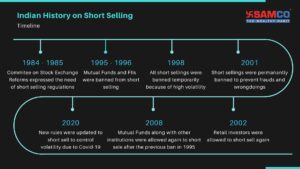Short Selling in India:
Here is a brief timeline history about short selling regulation in India - Every country follows a certain set of rules authorized by their regulatory body.
In India, the Securities and Exchange Board of India (SEBI) allows traders to short sell equity only in intraday trade. So, your borrowing duration from your broker will be of one day only. If you don't buy back the shares you have shorted before the market closes, your broker will automatically do that on your behalf. This usually happens around 3:15 PM but varies with each broker. This is known as square-off.
It can happen that shares you short might not go down as expected. Regardless, you will have to square off your position. You cannot carry forward your equity short sell position in India.
The spread of Covid-19 has shaken up financial markets. The global market crashed due to negative sentiments. Indian markets also saw a sharp fall with extreme bearishness. In an attempt to stabilize the market, SEBI imposed a ban on short-selling in March 2020. It remained in force till November 26, 2020. They also increased margin requirements to combat the panic situation.
The Indian regulator was not alone in banning short selling. Europe, China, Indonesia, and South Korea too prohibited short selling to control volatility in stocks. The ban was lifted by the end of 2020 except in South Korea. In an attempt to avoid a short squeeze, South Korea had been under the world’s longest short-selling restriction.
Every country follows a certain set of rules authorized by their regulatory body.
In India, the Securities and Exchange Board of India (SEBI) allows traders to short sell equity only in intraday trade. So, your borrowing duration from your broker will be of one day only. If you don't buy back the shares you have shorted before the market closes, your broker will automatically do that on your behalf. This usually happens around 3:15 PM but varies with each broker. This is known as square-off.
It can happen that shares you short might not go down as expected. Regardless, you will have to square off your position. You cannot carry forward your equity short sell position in India.
The spread of Covid-19 has shaken up financial markets. The global market crashed due to negative sentiments. Indian markets also saw a sharp fall with extreme bearishness. In an attempt to stabilize the market, SEBI imposed a ban on short-selling in March 2020. It remained in force till November 26, 2020. They also increased margin requirements to combat the panic situation.
The Indian regulator was not alone in banning short selling. Europe, China, Indonesia, and South Korea too prohibited short selling to control volatility in stocks. The ban was lifted by the end of 2020 except in South Korea. In an attempt to avoid a short squeeze, South Korea had been under the world’s longest short-selling restriction.
How to Start Trading in India?
To start trading in share market, you need to open a Demat and trading account. The broker must be a SEBI registered broker only. A Demat account holds your shares in electronic form. Whereas, a trading account helps you buy and sell shares through the stock exchanges. Intraday trading involves buying and selling stocks within the same trading day. Since equity short selling can only be done in intraday trading, the trader needs to select an MIS order.Common Myths About Short Selling:
Many investors argue that short selling manipulates the market and can cause a market crash. But are these facts or myths? Does short selling really manipulate the market? Before you start short selling it's important to have an understanding of the share market. Here are two common myths associated with short selling -- It manipulates the market
- It is responsible for major volatility in share price



 Easy & quick
Easy & quick
Leave A Comment?